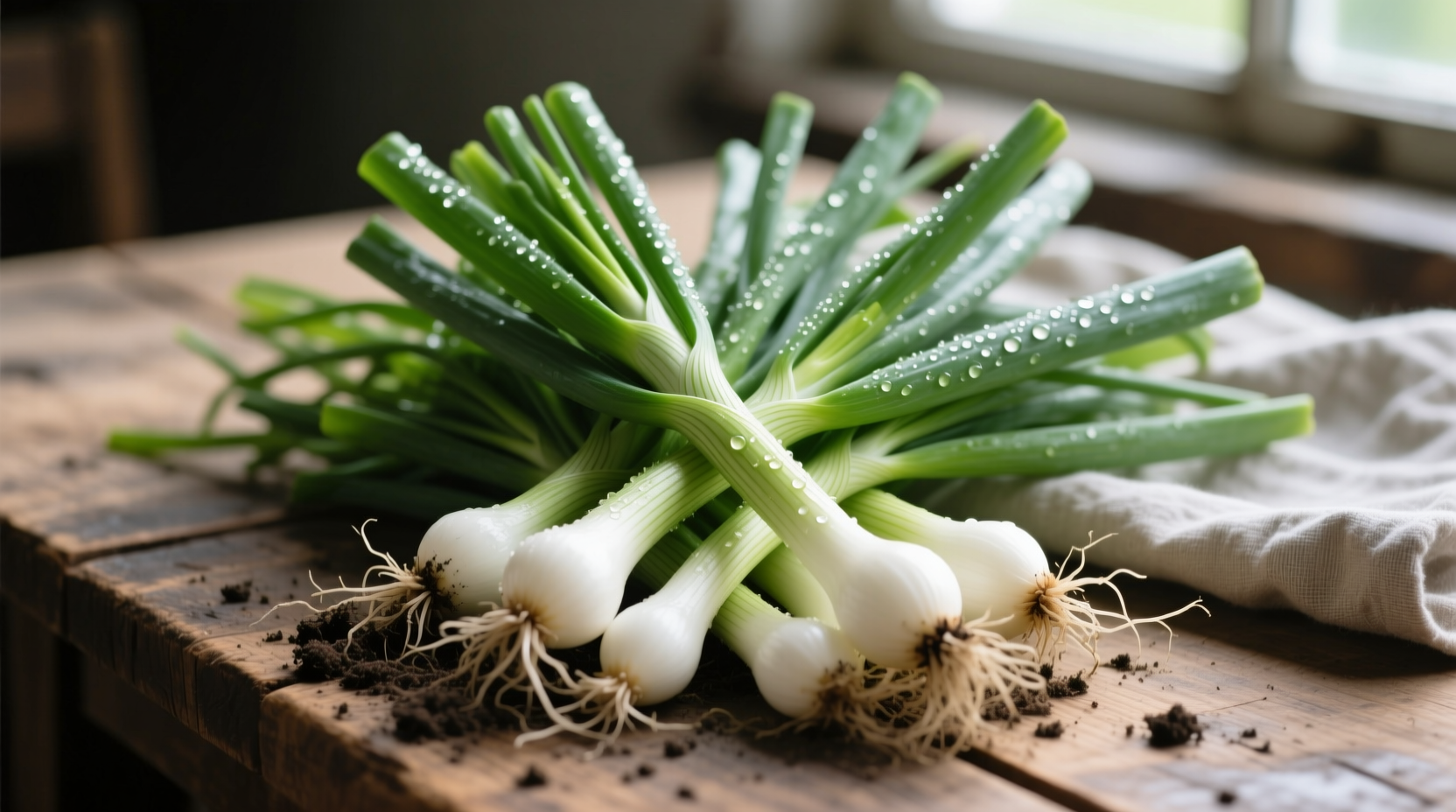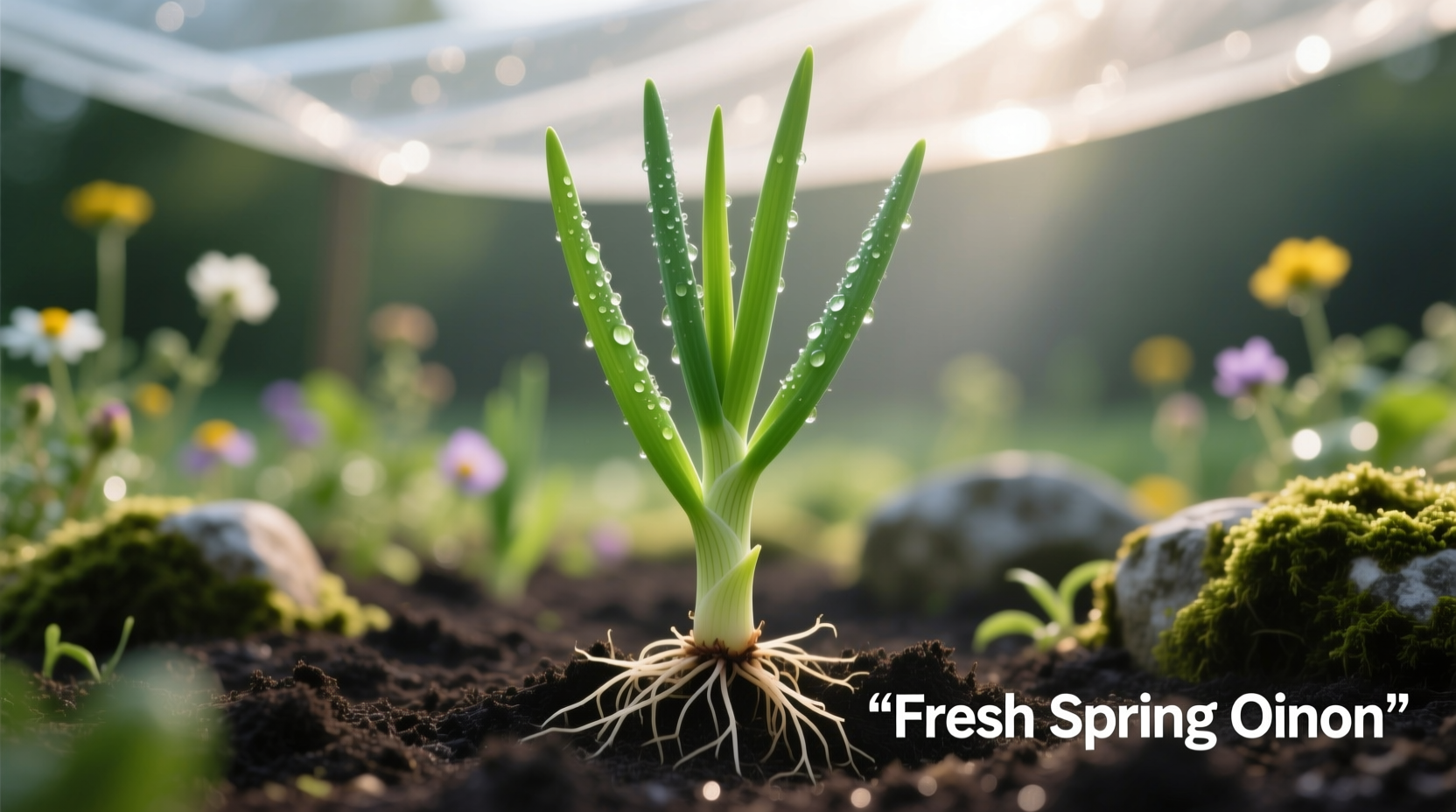Discover how to grow perfect spring onions in your garden with this complete guide. Whether you're a beginner gardener or looking to refine your technique, you'll learn optimal planting times, soil requirements, care practices, and harvesting methods that yield crisp, flavorful results all season long. Our evidence-based approach draws from agricultural research to help you avoid common mistakes and maximize your harvest.
Understanding Spring Onions: More Than Just Baby Onions
Spring onions, also known as scallions or green onions, represent a specific harvesting stage of certain onion varieties rather than a distinct species. Unlike regular onions that develop large bulbs, spring onions are harvested when the white base is still slender and the green tops are vibrant and crisp. The Allium fistulosum species, commonly called Welsh onions or bunching onions, never forms a large bulb, making them ideal for continuous harvesting.
According to the USDA Agricultural Research Service, spring onions contain significant amounts of vitamin C, vitamin K, and antioxidants, with their nutritional profile varying based on growing conditions and harvest time. Their mild flavor makes them versatile in culinary applications while providing health benefits associated with the Allium family.
| Variety | Days to Maturity | Best Climate Zone | Unique Characteristics |
|---|---|---|---|
| White Lisbon | 60-70 | 3-10 | Mild flavor, excellent cold tolerance |
| Evergreen Hardy White | 70-80 | 2-10 | Winter-hardy, consistent production |
| Red Beard | 65-75 | 4-9 | Purple-tinged stems, slightly stronger flavor |
| Japanese Bunching | 50-60 | 3-11 | Very fast growing, ideal for containers |
Your Spring Onion Growing Timeline: From Seed to Harvest
Successful spring onion cultivation follows a predictable timeline that varies slightly based on your climate zone. Understanding this progression helps you anticipate care needs and identify potential problems early:
- Days 1-7: Seed germination occurs in soil temperatures between 50-75°F (10-24°C). Maintain consistent moisture during this critical phase.
- Days 8-21: Seedlings establish root systems and develop first true leaves. Thin to 1-2 inches apart when plants reach 2 inches tall.
- Days 22-45: Rapid growth phase where plants develop characteristic white bases. This stage requires consistent watering and light feeding.
- Days 46-60: Bulb formation begins. For true spring onions, harvest before significant bulb development occurs.
- Days 61-80: Optimal harvest window for most varieties. Delaying harvest risks stronger flavor and potential bolting.
Research from the University of California Cooperative Extension shows that spring onions grown in cooler temperatures (60-70°F) develop sweeter flavors compared to those grown in hotter conditions, which can become pungent more quickly.
Planting Your Spring Onions for Success
The timing of your planting significantly impacts your spring onion harvest. Unlike regular onions that require specific day lengths to bulb properly, spring onions are less sensitive to photoperiod, making them suitable for multiple planting windows throughout the year.
In most climate zones, you can plant spring onions:
- Early spring: As soon as soil can be worked (typically soil temperature above 50°F/10°C)
- Late summer: For fall harvest (plant 8-10 weeks before first expected frost)
- Early fall: In zones 7+ for overwintering and early spring harvest
For best results when learning how to grow spring onions from seed, sow seeds 1/4 inch deep in well-prepared soil with good drainage. Space rows 12-18 inches apart to allow for weeding and air circulation. If using sets (small pre-grown bulbs), plant them just below the soil surface with the pointed end up.

Essential Care Practices for Healthy Plants
Proper care ensures your spring onions develop their characteristic mild flavor and crisp texture. Unlike mature onions that require drying down before harvest, spring onions need consistent moisture throughout their growth cycle.
Watering Requirements
Spring onions require about 1 inch of water per week, either from rainfall or irrigation. The Royal Horticultural Society recommends watering in the morning to reduce disease risk and maintaining consistent soil moisture to prevent splitting or premature bolting. During hot, dry periods, you may need to water twice weekly to keep the soil evenly moist.
Fertilization Strategy
These fast-growing plants benefit from nitrogen-rich fertilizer applied at planting time. A balanced 10-10-10 fertilizer at 1 pound per 100 square feet provides adequate nutrition. For organic options, well-rotted compost or fish emulsion works well. Avoid excessive nitrogen, which can lead to excessive leaf growth at the expense of flavor development.
Thinning for Optimal Growth
One of the most overlooked aspects of spring onion care and maintenance is proper thinning. When seedlings reach 2-3 inches tall, thin them to 1-2 inches apart. The thinnings themselves make delicious baby spring onions for salads. This spacing prevents overcrowding, which can lead to smaller harvests and increased disease susceptibility.
Climate Considerations for Spring Onion Success
While spring onions are relatively adaptable, understanding your specific climate zone helps optimize planting times and variety selection. The USDA Plant Hardiness Zone Map provides essential guidance for gardeners across North America.
Key climate considerations include:
- Cooler zones (3-5): Focus on spring and late summer plantings. Overwintering is challenging without protection.
- Moderate zones (6-8): Ideal for both spring and fall crops with potential for overwintering in protected beds.
- Warmer zones (9-11): Can grow spring onions year-round with summer shade protection to prevent bolting.
According to Cornell University's gardening resources, gardeners in zones 7-10 can successfully overwinter spring onions by planting in late fall and protecting plants with 2-3 inches of mulch during the coldest months, yielding an early spring harvest.
Common Challenges and Solutions
Even with proper care, you might encounter some issues when growing spring onions. Understanding these common spring onion pests and diseases helps you address problems before they ruin your crop.
Pest Management
The most frequent pests include:
- Thrips: Tiny insects causing silvery streaks on leaves. Control with insecticidal soap or neem oil.
- Onion maggots: Larvae that feed on roots. Prevent with row covers and crop rotation.
- Aphids: Small clusters on stems. Blast off with water or use insecticidal soap.
Disease Prevention
Prevent these common issues:
- Pink root: Fungal disease causing pink discoloration. Avoid by rotating crops and improving drainage.
- Downy mildew: Appears as yellow spots on leaves. Prevent with proper spacing for air circulation.
- Bolting: Premature flowering. Prevent by planting at proper times and maintaining consistent moisture.
Harvesting and Storage Techniques
Knowing when to harvest spring onions makes all the difference in flavor and texture. The ideal harvest window is narrow—typically just 7-10 days for peak quality.
Look for these signs that your spring onions are ready:
- Green tops are 6-8 inches tall and vibrant green
- White base measures about 1/2 inch in diameter
- Plants feel firm when gently squeezed
- No significant bulb formation at the base
To harvest, gently loosen the soil around the plants with a garden fork, then pull carefully. For continuous harvest, cut what you need 1 inch above the soil line, allowing regrowth for 2-3 additional harvests.
For storage, trim roots and tops to 2 inches, then place in a plastic bag with small holes in the refrigerator's crisper drawer. Properly stored spring onions maintain quality for 2-3 weeks. For longer storage, freeze chopped onions in ice cube trays with water or oil.
Maximizing Your Spring Onion Harvest
Spring onions offer culinary versatility beyond simple garnishes. Their mild flavor works well in both raw and cooked applications. Try these techniques to get the most from your harvest:
- Use the entire plant—white bases for cooking, green tops for garnishing
- Add to stir-fries during the last minute of cooking to preserve texture
- Create flavored oils by steeping chopped onions in olive oil
- Make spring onion butter by mixing finely chopped onions with softened butter
- Preserve excess harvest by pickling in vinegar with herbs
Professional chefs often separate the white and green parts when cooking, adding whites earlier for flavor development and greens at the end for color and fresh taste. This technique maximizes both flavor and visual appeal in dishes.
Troubleshooting Your Spring Onion Growth
If your spring onions aren't performing as expected, these common issues and solutions might help:
- Thin, weak growth: Usually indicates overcrowding or nutrient deficiency. Thin plants and apply balanced fertilizer.
- Excessive leaf growth, no white base: Too much nitrogen. Reduce fertilization and ensure proper spacing.
- Bitter flavor: Often caused by drought stress or harvesting too late. Maintain consistent moisture and harvest at proper size.
- Yellowing leaves: Could indicate overwatering, nutrient deficiency, or disease. Check soil moisture and inspect for pests.
Remember that spring onions grow quickly, so problems can develop rapidly. Regular monitoring (at least twice weekly) helps catch issues before they become serious.











 浙公网安备
33010002000092号
浙公网安备
33010002000092号 浙B2-20120091-4
浙B2-20120091-4